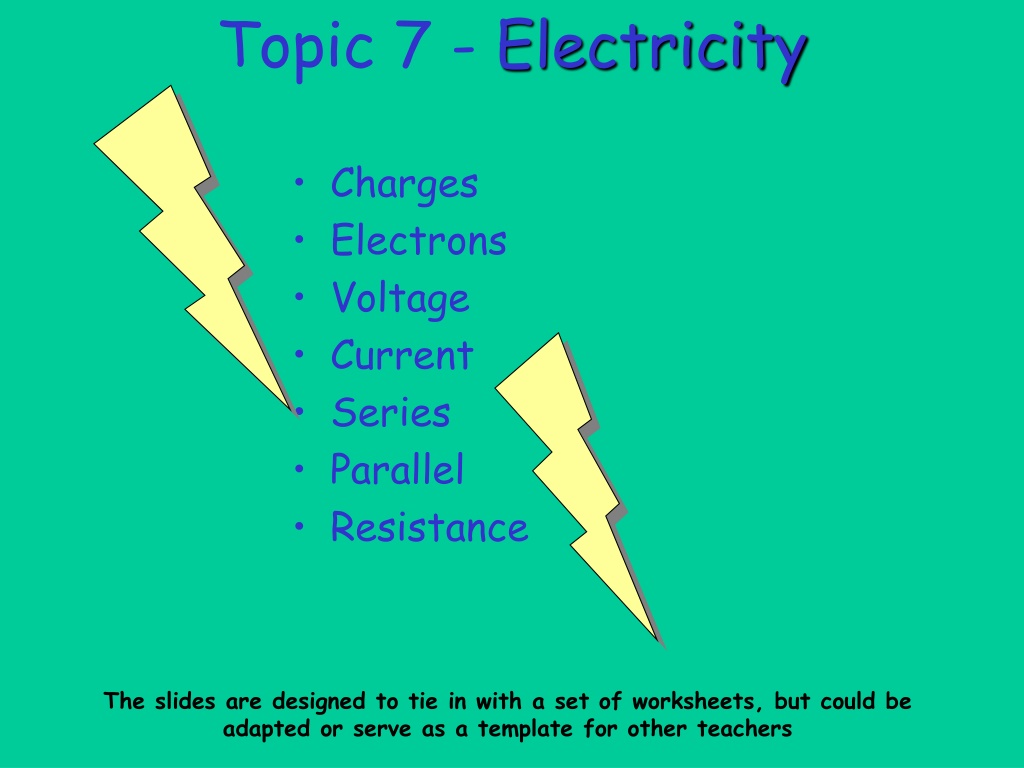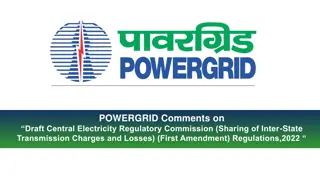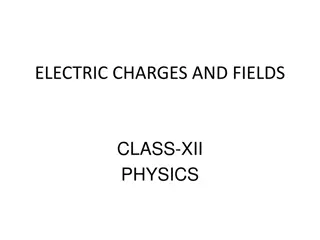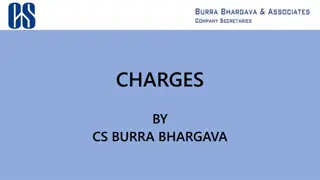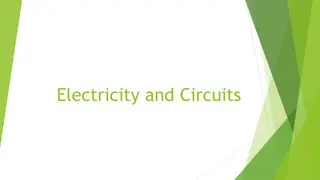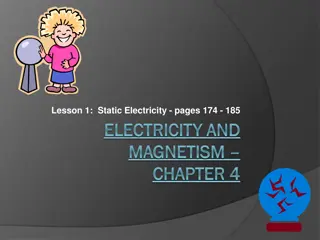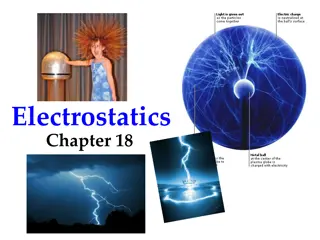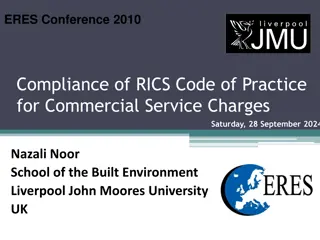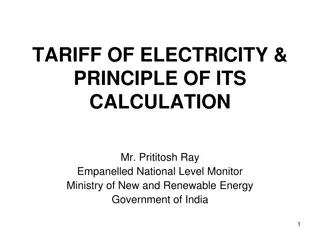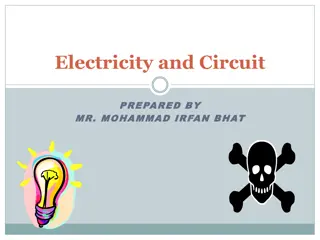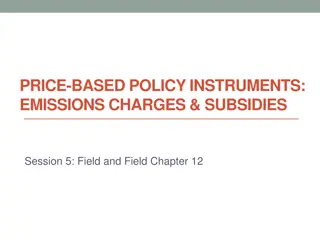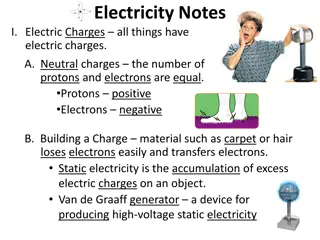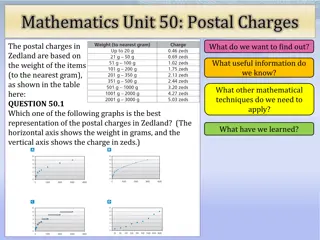Understanding Electricity and Charges: A Teaching Resource
Explore the fascinating world of electricity, charges, electrons, voltage, current, series, parallel circuits, and resistance through engaging slides designed to complement worksheets. Discover hands-on experiments that illustrate concepts like rubbing plastic to create static charges, observing effects on gold leaf, and exploring the behavior of charged objects. Dive into the principles of attraction and repulsion, and learn about patterns in object interactions. Enhance your teaching materials or use this as a template for creating dynamic lessons on electricity.
Download Presentation

Please find below an Image/Link to download the presentation.
The content on the website is provided AS IS for your information and personal use only. It may not be sold, licensed, or shared on other websites without obtaining consent from the author. Download presentation by click this link. If you encounter any issues during the download, it is possible that the publisher has removed the file from their server.
E N D
Presentation Transcript
Topic 7 - Electricity Charges Electrons Voltage Current Series Parallel Resistance The slides are designed to tie in with a set of worksheets, but could be adapted or serve as a template for other teachers
Topic 7 page 1 rubbing it 4. I charged up a plastic comb by with a duster/pulling it through my hair When I put the charged-up comb near some foil the foil jumped up to stick to the comb
Topic 7 page 2 What it was rubbed on Item Did the bits of foil move? yes yes yes no yes no Plastic comb Plastic ruler Plastic bag Wooden ruler Plastic pen Metal spatula hair hair cloth cloth cloth cloth
Topic 7 page 3 The electroscope Stop!
Topic 7 page 4 Effect on Gold Leaf Rises up Rises up Rises up Rises up Object Charged Plastic comb Plastic rod Plastic bag Plastic ruler If an uncharged object is brought near an electroscope the gold leaf If a charged object is brought near an electroscope the gold leaf doesn t move. rises up.
Topic 7 page 6 Pulling and Pushing Charged object 1 Comb Cling film Cling film Polythene rod Polythene rod Perspex rod Charged object 2 Cling film Cling film Piece of record Polythene rod Perspex rod Perspex rod What happened? Pull together Push apart Pull together Push apart Pull together Push apart
Topic 7 page 6 Is there a pattern? Charged object 1 Comb Cling film Cling film Polythene rod Polythene rod Perspex rod Charged object 2 Cling film Cling film Piece of record Polythene rod Perspex rod Perspex rod same What happened? Pull together Push apart Push apart Pull together different Pull together same different Pull together Push apart Push apart Pull together same different Pull together Push apart Push apart
Topic 7 page 6 5. If the charged objects are the same material then they will repel
Topic 7 page 7 Where Does Charge Come From? The centre of the atom contains both yellow neutrons and green positive protons Around the outside are the negative electrons
Topic 7 page 7 1. There are kinds of electrical charge called positive and negative two 2.a) To make an object positively charged you need to b) To make an object negatively charged you need to add negative charges remove negative charges 3. If a substance is neutral it means that the negative charges are exactly balanced by the positive charges
Topic 7 page 8 4. Two charged polythene rods will repel because they have the same charge 5. A cleaned mirror will be dusty within 24hrs because the charge attracts dust 6. A woolen jersey could be attracted to a nylon shirt because opposite charges which would attract they would have
Topic 7 page 10 1. A Van de Graff generator stores a negative charge builds up and 2. a) Your hair stands on end when you touch a Van de Graff generator because negatively charged and repel each other your hairs become b) Your hair goes down when you touch a water tap because the negative charges leave you flowing along the pipes to the ground and the hairs stop repelling
Topic 7 page 11 moving When a flows, charges are current - - - - - - - - - - - Now fill the blanks
Topic 7 page12 Battery A Switch Ammeter Bulb
Topic 7 page 13 Part of circuitStatement Battery measures current Bulb pushes the current Switch changes electrical energy to light Ammeter carries current round circuit Connecting wire turns the current on and off
Topic 7 page 14 Dim bulb small current - large current Bright bulb The a bulb the bigger the brighter current
Topic 7 page 14 1. a) An electric circuit electricity can flow along is a path that no gaps allowing b) A complete circuit has electricity to flow along it 5. A B C D 0.2A 0.5A 0.65A 0.95A
Topic 7 page15 A. A A
Topic 7 page15 B. A A
Topic 7 page15 V C. V
Topic 7 page 17 pushes the current through the wires conduct the electricity measures the current opens and closes a gap 2a)The battery b) The wires c) The ammeter d) The switch 3a) The energy change in the bulb is Electrical energy Light energy b) The energy change in the battery is Chemical energy Electrical energy 4a) Electricians use symbols to diagrams clearer and tidier make their
Topic 7 page 18 X A 0.2 A A 0.2 Z Y A A 0.2 0.2 0.2 0.2 Current at X Current at Y Current at Z A A A In a series circuit the current is the at all points in the circuit. same
Topic 7 page 19 A 0.4 Z X A 0.2 Y A 0.2 In a parallel circuit the current taken from the battery the sum of the currents through the two bulbs 0.2 0.2 0.4 Current at X Current at Y Current at Z A A A equals
Topic 7 page 20 Q1. The two bulbs in circuit B make less light than the one bulb in circuit A because the current between two (dim) bulbs B shares one of Q2. No current flows in circuit C because the bulbs is blown creating a break in the circuit Q3. Q4. House lights are better wired in parallel than series; a) b) don t dim bulb doesn t put whole house into darkness Broken
Using Voltmeters and Ammeters Voltmeter connected in parallel V A Ammeter connected in series
Correctly Wired? No! The voltmeter has been connected in series it should be parallel V
Correctly Wired? No the Ammeter has been connected in parallel it should have been series A
Correctly Wired? Yes! This Ammeter has been connected correctly in series A
Correctly Wired? Yes! This Ammeter has been connected correctly in series A
Correctly Wired? V Yes! The Voltmeter has been connected correctly in parallel
Correctly Wired? Yes! The Ammeter has been connected correctly in series A
Effects of Series? As more bulbs are added in series the bulbs grow dimmer
Topic 7 page 23 Circuit Diagram Conductors Insulators Iron Brass Copper Steel Graphite Plastic Rubber Perspex Glass Wood
Topic 7 page 25 Wire Nichrome Observation Glows red hot Use Electric fire Conducts doesn t get hot Heats up and melts copper Conducting wires Tin-lead Safety fuse
Topic 7 page 26, 27 Battery Battery voltage 1.5 V 6 V 12 V Bulb brightness dim brighter bright 1. 2. 3. When the voltage increases the current increases
Topic 7 page 28 5. Write down your ideas. The more batteries the brighter the bulb This holds true as long as the batteries face the same way If batteries are reversed they cancel each other out Elephant handout
Topic 7 page 29 Text Animation 1
Topic 7 page 30 Title: Choosing the best type of cable Aim: thick/thin, long/short wires and find the best Test thick and thin wires in a circuit and measure how it affects the current using an ammeter. Then test copper/nichrome and long/short wires. To compare copper/nichrome, Method:
Topic 7 page 30 Diagram: A bulb may be used instead of an ammeter Results: Wire long short copper nichrome thick thin Current A
Topic 7 page 30 Conclusion: Short wires are better than long wires. Copper wires are better than nichrome wires. Thick wires are better than thin wires.
Topic 7 page 31 Copper has a resistance than nichrome lower Thin wires have resistance than thick ones higher higher Longer wires have resistance than short ones
Topic 7 page 32 The variable resistor 4. Write down what you found out. The longer the wire (coil) the dimmer the bulb, the shorter the wire the brighter the bulb.
Topic 7 page 33 The variable resistor Write down what you found out. The longer the wire (coil) the smaller the current and the dimmer the bulb. The longer wire has a higher resistance.
Topic 7 page 35 1. A long thin nichrome wire has a higher resistance because resistance, as does copper and short wires. thick has a lower 2. a) Thick copper wires are good for carrying current because good conductor and thick wires have low resistance copper is a b) Long thin coils of nichrome are used in electric fires because a high resistance causing it to heat up without melting nichrome has
Topic 7 page 35 3. A variable resistor is used to increase and decrease the current by changing the length of a resistance wire 4. When the volume on a radio is turned Down the resistance wire is lengthened, causing a reduction in the current. because they 5. Cookers need thick cabling use much more current than lamps
Topic 7 page 36 The purpose of a fuse is from a short circuit - safety to protect you Not to make the device work
Circuit Symbols (components used in slides) A V You can find more downloads and help at www.lab6.co.uk
